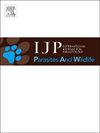Diphyllobothrium stemmacephalum infections in harbor porpoises (Phocoena Phocoena) in German waters
IF 2
3区 医学
Q3 ECOLOGY
International Journal for Parasitology-Parasites and Wildlife
Pub Date : 2025-05-02
DOI:10.1016/j.ijppaw.2025.101076
引用次数: 0
Abstract
Harbor porpoises (Phocoena) are definitive hosts for intestinal Diphyllobothrium sp. cestodes, zoonotic parasites with a heterogeneous life cycle and fishes as second intermediate hosts. Prevalence and level of infection of Diphyllobothrium cestodes in 661 dead-found harbor porpoises from the German North and Baltic Seas within a 30-year period were investigated. Molecular species identification of cestodes was carried out, using ribosomal and mitochondrial gene markers. Pathogenic impact of cestodes on intestinal tissue was analyzed by using review of histopathological records. With 18 cestode-infected harbor porpoises, prevalence was low (3 %) in both ecosystems. Infected animals were mostly young and exhibited mild infection levels. Cestode infection did not contribute significantly to cause of death and disease of the infected individuals and histopathological alterations of intestinal tissue were mostly mild. Tapeworms were molecularly identified as D. stemmacephalum. The findings validate past morphological records in the study area for the first time and confirm harbor porpoises as definitive hosts for D. stemmacephalum. D. stemmacephalum can accidentally infect humans. Future research on cetacean definitive host populations and species-specificity as well as life cycle and intermediate host species of D. stemmacephalum is crucial for a risk assessment in the sense of the One Health concept.

德国水域港鼠(Phocoena Phocoena)中干头双叶杆菌感染
港鼠(Phocoena)是肠道双叶虫属寄生虫(Diphyllobothrium sp. cestodes)的最终宿主,具有异质生命周期的人畜共患寄生虫和鱼类作为第二中间宿主。对德国北部和波罗的海661只死港鼠进行了30年的调查。利用核糖体和线粒体基因标记对该类动物进行了分子物种鉴定。通过对组织病理记录的回顾,分析了绦虫对肠道组织的致病作用。在这两个生态系统中,18只感染了血吸虫的港湾鼠海豚的患病率都很低(3%)。受感染的动物大多为幼龄动物,表现出轻度感染水平。血吸虫感染对感染个体的死亡和疾病无显著影响,肠道组织病理改变多为轻度。经分子鉴定,绦虫属D. stemmacephalum。这一发现首次验证了过去在研究区域的形态学记录,并证实了港鼠是D. stemmacephalum的最终宿主。stemmacephalum可以意外感染人类。未来对鲸类动物最终寄主种群和物种特异性以及D. stemmacephalum的生命周期和中间寄主物种的研究对于同一个健康概念意义上的风险评估至关重要。
本文章由计算机程序翻译,如有差异,请以英文原文为准。
求助全文
约1分钟内获得全文
求助全文
来源期刊

International Journal for Parasitology-Parasites and Wildlife
Medicine-Infectious Diseases
CiteScore
3.80
自引率
5.60%
发文量
113
审稿时长
45 days
期刊介绍:
The International Journal for Parasitology: Parasites and Wildlife (IJP-PAW) publishes the results of original research on parasites of all wildlife, invertebrate and vertebrate. This includes free-ranging, wild populations, as well as captive wildlife, semi-domesticated species (e.g. reindeer) and farmed populations of recently domesticated or wild-captured species (e.g. cultured fishes). Articles on all aspects of wildlife parasitology are welcomed including taxonomy, biodiversity and distribution, ecology and epidemiology, population biology and host-parasite relationships. The impact of parasites on the health and conservation of wildlife is seen as an important area covered by the journal especially the potential role of environmental factors, for example climate. Also important to the journal is ''one health'' and the nature of interactions between wildlife, people and domestic animals, including disease emergence and zoonoses.
 求助内容:
求助内容: 应助结果提醒方式:
应助结果提醒方式:


